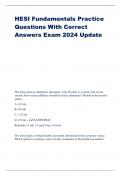HESI Fundamentals Practice
Questions With Correct
Answers Exam 2024 Update
The nurse plans to administer diazepam, 4 mg IV push, to a client with severe
anxiety. How many milliliters should the nurse administer? (Round to the nearest
tenth.)
A. 0.2 mL
B. 0.8 mL
C. 1.25 mL
D. 2.0 mL - ✔✔✔ANSWER-B
Rationale: (1 mL × 4 mg)/5 mg = 0.8 mL
The nurse plans to obtain health assessment information from a primary source.
Which option is a primary source for the completion of the health assessment?
,A) Client.
B) Healthcare provider.
C) A family member.
D) Previous medical records - ✔✔✔ANSWER-A) Client
A primary source of information for a health assessment is the client (A). (B, C,
and D) are considered secondary sources about the client's health history, but other
details, such as subjective data, can only be provided directly from the client.
The nurse prepares to insert a nasogastric tube in a client with hyperemesis who is
awake and alert. Which intervention(s) is(are) correct? (Select all that apply.)
A. Place the client in a high Fowler position.
B. Help the client assume a left side-lying position.
C. Measure the tube from the tip of the nose to the umbilicus.
D. Instruct the client to swallow after the tube has passed the pharynx.
E. Assist the client in extending the neck back so the tube may enter the larynx. -
✔✔✔ANSWER-A, D
Rationale:
(A and D) are the correct steps to follow during nasogastric intubation. Only the
unconscious or obtunded client should be placed in a left side-lying position (B).
The tube should be measured from the tip of the nose to behind the ear and then
from behind the ear to the xiphoid process (C). The neck should only be extended
back prior to the tube passing the pharynx and then the client should be instructed
to position the neck forward (E).
The nurse recognizes that which are important components of a neurovascular
assessment? Select all that apply.
1
,Orientation
2
Capillary refill
3
Pupillary response
4
Respiratory rate
5
Pulse and skin temperature
6
Movement and sensation - ✔✔✔ANSWER-2,5,6,
A neurovascular assessment involves evaluation of nerve and blood supply to an
extremity involved in an injury. The area involved may include an orthopedic
and/or soft tissue injury. A correct neurovascular assessment should include
evaluation of capillary refill, pulses, warmth and paresthesias, and movement and
sensation. Orientation, pupillary response, and respiratory rate are components of a
neurological assessment.
"It shows the time needed for the SA node impulse to depolarize the atria and
travel through the AV node."
Explanation:
The PR interval is measured from the beginning of the P wave to the beginning of
the QRS complex and represents the time needed for sinus node stimulation, atrial
depolarization, and conduction through the AV node before ventricular
depolarization. In a normal heart the impulses do not travel backward. The PR
interval does not include the time it take to travel through the Purkinje fibers -
✔✔✔ANSWER-P-R interval
0.24 seconds
, Explanation:
In adults, the normal range for the PR is 0.12 to 0.20 seconds. A PR internal of
0.24 seconds would indicate a first-degree heart block. - ✔✔✔ANSWER-Which
PR interval presents a first-degree heart block?
3 checks of safe medication administration - ✔✔✔ANSWER-1) Before you pour,
mix, or draw up a medication
2) After you prepare the medication
3) At the bedside
5 stages of infection - ✔✔✔ANSWER-Incubation, prodromal, illness, decline,
convalescence
64.A low-sodium, low-protein diet is prescribed for a 45-year-old client with renal
insufficiency and hypertension, who gained 3 pounds in the last month. The nurse
determines that the client has been noncompliant with the diet, based on which
report from the 24-hour dietary recall? (Select all that apply.)
A. Snack of potato chips, and diet soda.
B. Lunch of tuna fish sandwich, carrot sticks, fresh fruit, and coffee.
C. Breakfast of eggs, bacon, toast, and coffee.
D. Dinner of vegetable lasagna, tossed salad, sherbet, and iced tea.
E. Bedtime snack of crackers and milk. - ✔✔✔ANSWER-Potato chips (A) are
high in sodium. Tuna (B) is high in protein. Bacon (C) and crackers (E) are high in
sodium. Only (D) is a meal that is in compliance with a low sodium, low protein
diet.
Correct Answer: A, B, C, E




